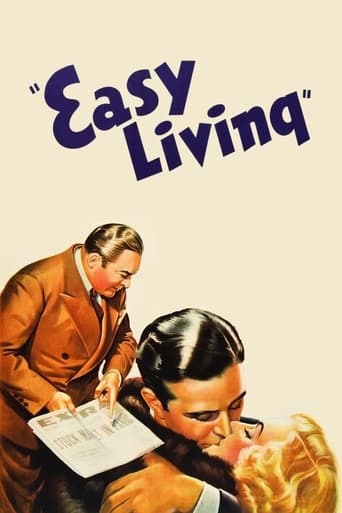wes-connors
Manhattan millionaire Edward Arnold (as John "J.B." Ball) is upset when he sees the bill for his wife's newest fur coat, a $58,000 sable. He tosses the coat off their Fifth Avenue rooftop and it lands on beautiful blonde Jean Arthur (as Mary Smith), ruining her feathered hat. She attempts to find the coat's owner, and meets Mr. Arnold. He gives Ms. Arthur the coat, and offers to buy her a new hat. Their swishy store clerk Franklin Pangborn (as Van Buren) starts a rumor hinting at a sexual relationship between Arthur and Arnold. When her straight-laced co-workers see Arthur in her expensive attire, she loses her job. Arthur may become homeless, but fate intervenes... When hotel owner Luis Alberni (as Louis Louis) learns about Arthur's alleged relationship, he invites her to stay in a luxurious suite. Enjoy Arthur surveying her beautiful hotel suite, without trying to remember all the steps that led her there. "Easy Living" doesn't transition clearly from situation to situation. Drawing on his past work, director Mitchell Leisen makes much of it look artful. He may have added additional slapstick to Preston Sturges' screenplay, which helps fill in the blanks. Also starring eligible young Ray Milland (as John Ball Jr.) and well-dressed Mary Nash (as Jenny Ball).******* Easy Living (7/7/37) Mitchell Leisen ~ Jean Arthur, Edward Arnold, Ray Milland, Luis Alberni
Tad Pole
. . . then the dimmest bulbs must flicker on Wall Street, and EASY LIVING proves that this fact was as well known to Americans in 1937 as it is today. The proverbial one-eyed man may be king in the Land of the Blind, but EASY LIVING illustrates why the possession of even one eye might be a definite handicap for the high rollers of Lower Manhattan. It's better to be completely blind, deaf, and dumb if you want to make your mark there. Jean Arthur plays "Mary Smith" in EASY LIVING, but she might as well be portraying Alice in Wonderland. Mary learns that among the rich, anything goes. The lifestyle props upon which they fritter away their wealth are so impractical and worthless, they constitute grounds for firing if displayed near a normal workplace. That's what happens to Mary when she inadvertently shows up wearing her "gift horse" (a sable fur coat) to work for her real people job. As this year's follow-up to EASY LIVING (THE BLING RING) shows, the forbidden candy most rich celebrities use to fill up their otherwise empty shell of lives can only corrupt NORMAL people (which helps explain why so many lottery winners soon off themselves). Since Mary Smith has a solid working class soul, she is oblivious to some of the temptations thrown her way in EASY LIVING, and triumphs over the rest, settling for live sheep dogs in lieu of murdered mink.
showtrmp
Another in the long line of extremely pleasurable comedies starring Jean Arthur--no one can make fluttery bewilderment more enchanting, and there's plenty to be bewildered about in this heavenly screwball farce. Arthur is poor, honest, hardworking Mary Smith, whose life is changed when a sable coat thrown out of a window lands on her head. She tries to return it, but the man who threw it, rich banker J.P. Ball (Edward Arnold), in a fit of pique at his wife's extravagance, insists she keep it, and even buys her a matching hat in a nearby store. The store's employees, assuming she's a fancy kept woman (the idea!) spread the word around town, and soon everyone in sight wants to be her best pal, not least of all Arnold's son (Ray Milland), who is trying to make his way in the world without his father's backing. Although scenes such as Arthur's dismissal from her job (for "ethical violations") have become dated (without losing their humor), the portrait of an entire city eagerly sucking up to a (supposed) rich man's consort in hopes something will rub off on them couldn't be more timely. The movie has some of the best choreographed pratfalls in the genre, not least of all in the celebrated Automat sequence, when the windows accidentally open and everyone scrambles for the free food. (It's slapstick Marxism). And Arthur's pleased yet skeptical reaction to the enormous hotel suite she's offered (it looks like it belongs in the Emerald City of Oz) is just right; she looks at the lily-shaped tub, which is crowned by a statue of a shrugging goddess, and comments, "Look at her standing there with her arms sticking out; I guess she doesn't know either.") The only wrong note (for me), is the performance of Luis Alberini as the hotel owner; his brand of dialect humor gets tiresome--I'd just as soon it was left in the thirties for good.
PWNYCNY
This is an amusing, entertaining Hollywood antique featuring a number of actors who became Hollywood icons such as Jean Arthur, Ray Milland, and Edward Arnold. Before Ed Asner there was Edward Arnold. Mr. Arnold was one of the greatest actors in Hollywood history. His performances were consistently great and through him a weak script became good and good script great. He was one of those actors who dominated the screen and could play a wide range of roles opposite some of the most famous Hollywood players. As for Jean Arthur, she specialized in a style of acting that established a precedent for Lucille Ball, except that Ms. Arthur did not have to act goofy. Movies from the 1930s were made in a certain style that was unique to that period. Black-and-white, simple, engaging, upbeat stories, lots of action, and optimistic about life - all this during the Great Depression. This is another Preston Sturges gem and definitely is worth watching.


